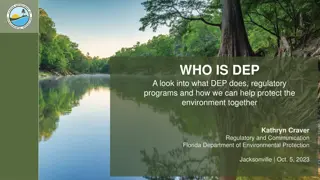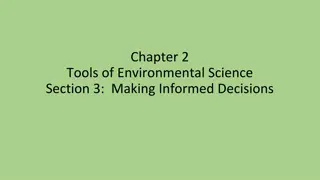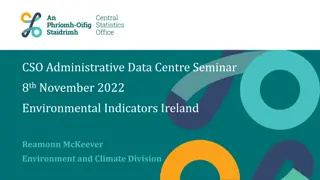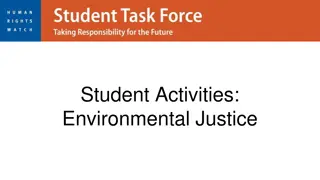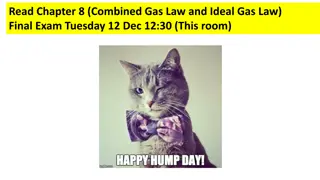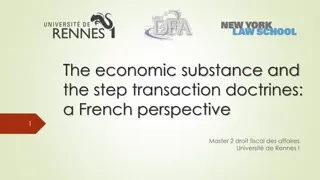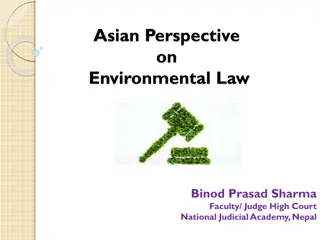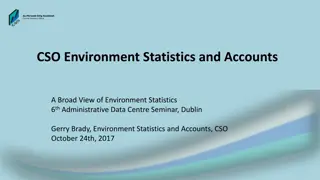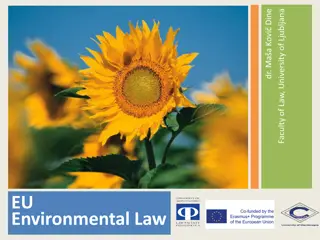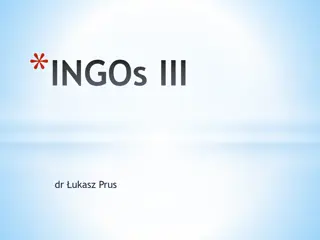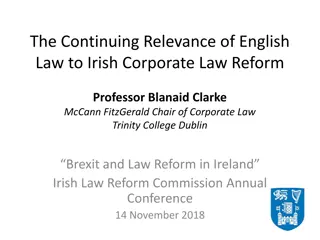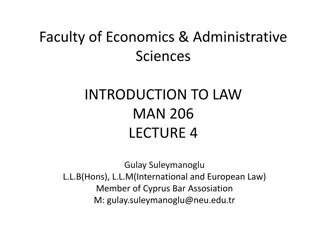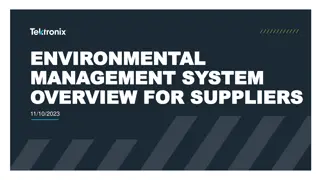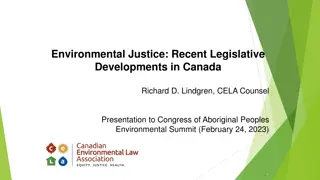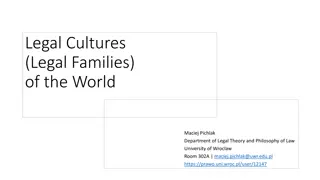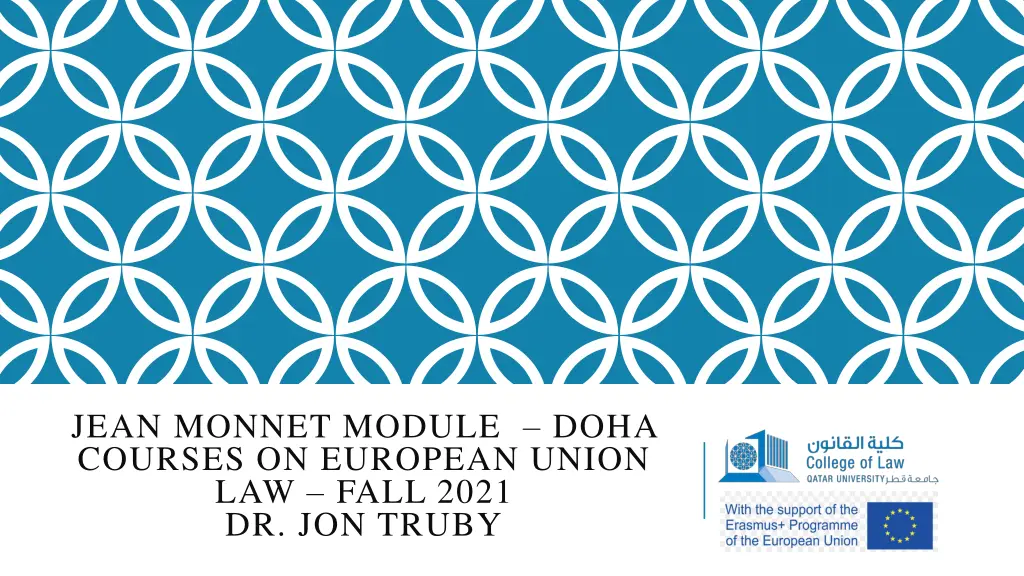
Resource Efficiency and Circular Economy Initiatives in the European Union
The European Union is implementing various initiatives to promote resource efficiency and circular economy practices to achieve sustainability and economic growth. The Roadmap to a Resource Efficient Europe and the Circular Economy Package are key frameworks driving this transition, aiming to reduce waste generation, enhance recycling and reuse, and foster global competitiveness while moving towards a cleaner, more sustainable future by 2050.
Download Presentation

Please find below an Image/Link to download the presentation.
The content on the website is provided AS IS for your information and personal use only. It may not be sold, licensed, or shared on other websites without obtaining consent from the author. If you encounter any issues during the download, it is possible that the publisher has removed the file from their server.
You are allowed to download the files provided on this website for personal or commercial use, subject to the condition that they are used lawfully. All files are the property of their respective owners.
The content on the website is provided AS IS for your information and personal use only. It may not be sold, licensed, or shared on other websites without obtaining consent from the author.
E N D
Presentation Transcript
JEAN MONNET MODULE DOHA COURSES ON EUROPEAN UNION LAW FALL 2021 DR. JON TRUBY
Resource Efficiency and the Circular Economy
Introduction EU waste policy has a long history and has traditionally focused on more environmentally sustainable waste management. The Roadmap to a Resource Efficient Europe and the Circular Economy Package should change this trend by transforming the EU s economy into a sustainable one by 2050. Under the European Green Deal, the new Circular Economy Action Plan provides a future-oriented agenda for achieving a cleaner and more competitive EU and fully contributing to climate neutrality.
Achievements All products have a natural basis. The EU s economy is highly dependent on natural resources. If current patterns are maintained, the degradation and depletion of natural resources will continue, as will waste generation. The scale of our current resource use is such that it is jeopardising the chances of future generations and developing countries of having access to their fair share of scarce resources. Rational utilisation of natural resources was one of the earliest environmental concerns underpinning the first European Treaties.
Achievements The Roadmap to a Resource Efficient Europe is among the key initiatives of the 7th Environment Action Programme (EAP). One of its main objectives is to unlock the EU s economic potential so that it can be more productive while using fewer resources and moving towards a circular economy. The Circular Economy Package includes measures that will help to stimulate the EU s transition towards a circular economy through greater recycling and reuse, boosting global competitiveness, fostering sustainable economic growth and generating new jobs.
Resource Efficiency The Roadmap to a Resource Efficient Europe is part of the resource efficiency flagship initiative of the Europe 2020 strategy. It supports the shift towards sustainable growth via a resource-efficient, low- carbon economy. The roadmap takes into account the progress made on: - 2005 Thematic Strategy on the Sustainable Use of Natural Resources (COM(2005)0670) - EU s Sustainable Development Strategy, and sets out a framework for the design and implementation of future action.
Waste Management and Prevention The Waste Framework Directive followed on from the Thematic Strategy on the Prevention and Recycling of Waste and repealed the previous Waste Framework Directive, the Hazardous Waste Directive and the Waste Oil Directive. It aimed to reform and simplify EU policy by introducing a new framework and setting new targets, with a focus on prevention. The Waste Shipment Regulation laid down rules for waste shipments both within the EU and between the EU and non-EU countries, with the specific aim of improving environmental protection.
Waste Management and Prevention It covered the shipment of practically all types of waste (with the exception of radioactive material) by road, rail, sea and air. Exports of hazardous waste to countries outside the Organisation for Economic Co-operation and Development (OECD) and exports of waste for disposal outside the EU/European Free Trade Association countries were prohibited. Illegal waste shipments have remained a serious problem; the new Regulation ((EU) No 660/2014) therefore aims to ensure more uniform implementation of the Waste Shipment Regulation.
Production- and Waste-Stream-Specific Laws Directive 2000/53/EC aimed to reduce waste from end-of-life vehicles (ELVs) and their components. It encouraged manufacturers and importers to limit the use of hazardous substances and to develop the integration of recycled materials. An implementation report showed that enforcing the ELV Directive has been problematic in many Member States, owing to gaps between the number of deregistered cars and the number of registered ELVs, and to illegal exports to developing countries.
Production- and Waste-Stream-Specific Laws The Ship Recycling Regulation entered into force on 2013. Its main objective was to prevent, reduce and eliminate accidents, injuries and other adverse effects on human health and the environment resulting from the recycling and treatment of EU ships, in particular with a view to ensuring that hazardous waste from such ship recycling is subject to environmentally sound management. The regulation set out a number of requirements for EU ships, EU ship-owners, ship recycling facilities willing to recycle EU ships, and the relevant competent authorities or administrations.
Production- and Waste-Stream-Specific Laws Directive 2002/96/EC, as amended by Directive 2008/34/EC, aimed to protect soil, water and air through better and reduced disposal of waste electrical and electronic equipment (WEEE). Directive 2002/95/EC on the restriction of the use of certain hazardous substances in electrical and electronic equipment (RoHS), adopted in parallel to the WEEE Directive, aimed to protect the environment and human health by restricting the use of lead, mercury, cadmium, chromium and brominated flame retardants in such equipment. The implementation of the WEEE and RoHS Directives in the Member States proved difficult, with only one third of all electrical and electronic waste being collected and properly treated.
Production- and Waste-Stream-Specific Laws Directive 2006/66/EC on batteries and accumulators and waste batteries and accumulators aimed to improve the waste management and environmental performance of such items by establishing rules for their collection, recycling, treatment and disposal. Amending Directive 2013/56/EC removed the exemption for button cells with a mercury content of no more than 2% by weight. In accordance with Council Directive 96/29/Euratom on radioactive waste and substances, each Member State had to make it compulsory to report activities that involve a hazard arising from ionising radiation. Shipments of radioactive waste are covered by Council Regulation (Euratom) No 1493/93 and Council Directive 2006/117/Euratom.
Production- and Waste-Stream-Specific Laws Directive 94/62/EC covered all packaging placed on the EU market and all packaging waste, whether it is used or released at industrial, commercial, office, shop, service, household or any other level. Amending Directive 2004/12/EC established criteria and clarified the definition of packaging . Directive (EU) 2015/720 amended Directive 94/62/EC as regards reducing the consumption of lightweight plastic carrier bags, which easily escape waste management streams and accumulate in our environment, especially in the form of marine litter.
Waste Treatment and Disposal The progressive implementation of the Urban Waste Water Treatment Directive in all the Member States increased the quantities of sewage sludge requiring disposal. The Landfill Directive intended to prevent or reduce the adverse effects of landfill on the environment, in particular on surface water, groundwater, soil and air, as well as on human health. Directive on the incineration of waste aimed to prevent or reduce, as far as possible, air, water and soil pollution caused by the incineration or co-incineration of waste. It was repealed and replaced by Directive 2010/75/EU on industrial emissions and related directives.
The 2018 Circular Economy Package In December 2015, the Commission presented an action plan on the circular economy, as well as four legislative proposals amending the following legal acts: (a) the Waste Framework Directive; (b) the Landfill Directive; (c) the Packaging and Packaging Waste Directive; (d) the directives on ELVs, on batteries and accumulators and waste batteries and accumulators, and on WEEE.
The 2018 Circular Economy Package The Waste Framework Directive required the Commission to take the following measures by the end of 2014: - Review the 2020 targets on the reuse and recycling of household waste and on construction and demolition waste, set waste prevention objectives for 2020, - Assess a number of measures, including extended producer responsibility schemes. The Landfill Directive required the Commission to review targets set therein by July 2014 and the Packaging Directive by the end of 2012.
The 2018 Circular Economy Package Adopted in 2018, the four directives ((EU) 2018/849, (EU) 2018/850, (EU) 2018/851 and (EU) 2018/852) incorporate the following key elements: - A common EU target to recycle 65% of municipal waste by 2035 (55% by 2025 and 60% by 2030); - Acommon EU target to recycle 70% of packaging waste by 2030; - A binding landfill target to reduce landfill to a maximum of 10% of municipal waste by 2035; - A ban on the landfilling of separately collected waste, requiring separate collection for biowaste by 2023 and for textiles and hazardous waste from households by 2025
Plastics in the Circular Economy On 16 January 2018, the Commission published a communication laying out a strategy for plastics in a circular economy. The strategy identifies key challenges, including the low reuse and recycling rates of plastic waste, the greenhouse gas emissions associated with plastics production and incineration, and the presence of plastic waste in oceans. The Commission proposes that all plastic packaging should be designed to be recyclable or reusable by 2030.
Plastics in the Circular Economy With a view to moving towards this target, the strategy presents a wide range of measures focusing on four areas: (1) improving the economics and quality of plastics recycling; (2) curbing plastic waste littering; (3) driving investment and innovation in the plastics value chain; and (4) harnessing global action. As part of the Plastics Strategy to tackle wasteful and damaging plastic litter through legislative action and following a Commission proposal of 28 May 2018, the Council and Parliament agreed to reduce plastic pollution by setting tough new restrictions on certain single-use plastic products (Directive (EU) 2019/904).
Plastics in the Circular Economy Products that will be banned in the EU include plastic cutlery (forks, knives, spoons and chopsticks), plastic plates and straws, food and beverage containers made of expanded polystyrene and cotton bud sticks made of plastic. From 2025 onwards, the Member States will have the binding target for all PET beverage bottles to contain at least 25% recycled plastic. By 2030, all plastic bottles will have to contain at least 30% recycled content.
The new Circular Economy Action Plan under the European Green Deal The new Circular Economy Action Plan for a cleaner and more competitive Europe was published in March 2020 and is one of the cornerstones of the European Green Deal, the EU s new agenda for sustainable growth. It announced initiatives along the entire life cycle of products, targeting e.g.: their design, promoting circular economy processes, fostering sustainable consumption, and aiming to ensure that the resources used are kept in the EU economy for as long as possible.
The new Circular Economy Action Plan under the European Green Deal The Commission adopted the first milestone of the action plan on 10 December 2020. It is a proposal for a regulation to modernise EU legislation on batteries. The aim is that batteries placed on the EU market are sustainable, circular, high- performing and safe throughout their entire life cycle and that they are collected, repurposed and recycled, becoming a true source of valuable raw materials. It includes mandatory requirements for all batteries (i.e. industrial, automotive, electric vehicle and portable) placed on the EU market.

